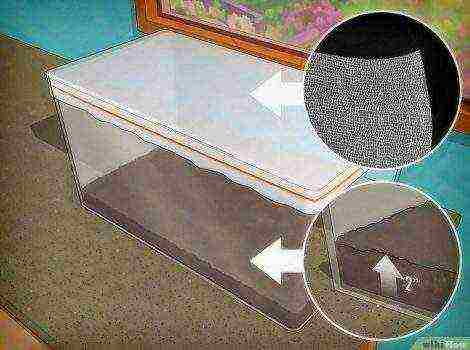Content
- 1 How to choose the right pineapple?
- 2 How to prepare for planting
- 3 Landing
- 4 Growing and care rules
- 5 How to plant pineapple at home
- 6 How to take care of pineapple
- 7 A few things that come in handy when growing pineapple at home. What is worth knowing
- 8 Video "How to grow pineapple at home from the top"
- 9 Description of the pineapple plant
- 10 Capacity and soil
- 11 Transplant and watering rules
- 12 How to stimulate pineapple flowering
- 13 Seed propagation of pineapple
Pineapples have been cultivated in greenhouses for a very long time. But it turns out that you can grow them yourself at home if you know how to plant a pineapple from its top. An unpretentious plant will grow even in northern regions with proper care. And decorating a festive table with a fruit grown by your own hands is a real pleasure for everyone.
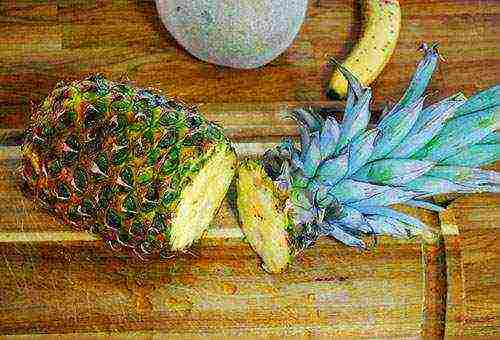
How to choose the right pineapple?
To get a new one from the cut pineapple top at home, you must choose the right product. That's right - it means buying a ripe, but not overripe fruit.
There are rules to help you make the right choice.
- Look for fresh pineapple in the store (a product lying on the counter for a long time may not give roots or a weak plant will develop from it).
- The crest should not be frostbitten.
- The top when viewed should be firm, not dry, with elastic bright green large leaves. The presence of dark spots, damage, cuts or dry ends on them is unacceptable.
- The pineapple itself should not be overripe and unripe. Ideally, it should have a golden-green rind, and the fruit itself should be firm.
The optimal time to buy the "right" product for the purpose of subsequent growing at home is considered to be the period from late summer to mid-autumn.
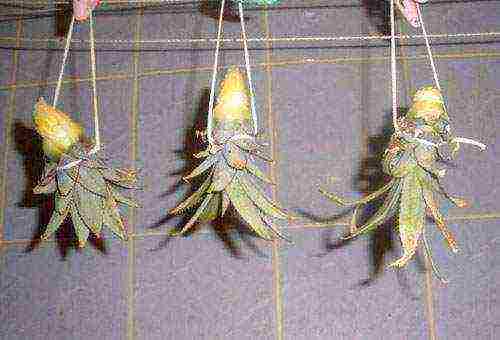
How to prepare for planting
Before planting a purchased pineapple, you should separate the tuft. This can be done using one of the options.
- Twisting: grasp the leaves with one hand, and with the other, holding the fruit, slowly twist the top out of it.
- Cutting: with a knife, carefully cut off the top of the fruit, leaving a distance of 4-5 cm to the leaves, while the lower leaves are removed, and the flesh is cut to a root 1.5-2 cm long.
The resulting "sprout" for disinfection is lowered into a weak solution of furacilin or potassium permanganate.
Advice
Instead of solutions, you can use wood ash, crushed activated carbon. The root can be sprinkled with one of them or you can prepare a mixture of them.
Drying of the top is considered an important point. It is wrapped with a cord, rope or wire and then hung up for 10-14 days. At the same time, its leaves should hang down.
Important!
This procedure will ensure the outflow of all substances important for the plant into the root formation zone and the cut will heal.

Landing
Growing a plant at home takes place in an ordinary flower pot with a volume of up to 0.5 liters with a drain for draining the water. Pebbles are laid out in a small layer on its bottom, and the container is filled with soil (mix garden soil, humus, peat, sand in equal amounts). You can buy ready-made soil (soil is suitable for growing plants from the Bromylium family).
Advice
Before planting (2-3 days), the prepared soil must be spilled with a hot solution of potassium permanganate. This will help protect the culture from bacteria or parasitic attack.
In the soil in the center of the pot, a small depression is made up to 3-5 cm deep, up to 5-7 cm wide (depending on the size of the planted root).To save the plant from rotting, crushed activated carbon can be poured into the recess. The root can rot from waterlogging of the soil or from insufficient drying.
Planting a plant is carried out according to the following rules.
- The root is located vertically in the recess, covered with earth and slightly compacted.
- The top is fixed to avoid tilting: sticks (plastic or wooden) are installed along the edges of the container. Threads connect each stick to the top.
- The soil is slightly moistened (it must not be poured).
- The plant is covered on top with a transparent container or polyethylene bag.
- The pot is placed at home in a sufficiently warm and well-lit place without drafts.
After 1-1.5 months, the tip will give roots. This can be determined by the young leaves that appear. The package (container) can be removed only after they appear.
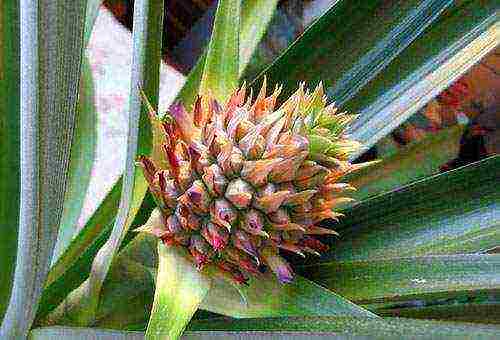
Growing and care rules
Pineapple is a non-capricious and unpretentious plant to grow. It does not require any special care. But there are several conditions that are important to consider.
- Temperature
The plant loves light and warmth. Growing pineapple from its top should take place at a temperature of 23-25 ° C. During the winter months, you can maintain the required temperature with a heater or lamp.
If the pot with the plant is on the windowsill, it must be protected from drafts and accidental frostbite.
- Watering
Being a tropical plant, pineapple easily tolerates heat and lack of moisture. The main mistake that flower growers make is frequent and abundant watering. At home, it should be watered abundantly only twice a week, and in winter this should be done even less often.
Important!
An excess of water will lead to root rot and death of the plant. Watering should be done only with warm water and when the soil in the pot is really dry!
It is not only the soil under the crop that should be watered. Water must also be poured into the leaves so that they can accumulate it in themselves.
- Top dressing
When growing pineapple at home, you do not need to often feed it with fertilizers. It is enough to apply any organic or complex fertilizer intended for indoor flowers 2 times a year.
Important!
Do not use alkaline top dressing (lime, ash). Even a small amount of them will lead the plant to death.
In order to prepare the culture for fruiting and enhance vegetative growth, in the third year, every 14 days it should be fed with any organic fertilizer. At home, for this purpose, you can use mullein infusion, which contains all the important trace elements. The infusion is prepared just a bucket of water (10 l) is filled with manure by a third, filled with water and infused for 5-8 days with periodic stirring. When the fermentation of manure is complete, the infusion is diluted with water in a ratio of 1: 8.
To stimulate fruiting and improve the quality of the future fetus, it is recommended to carry out another top dressing. It has proven itself well as a carbide stimulant. A small piece of it (12-15 g) is dropped into a container (1 liter) with water - bubbling and release of acetylene will be observed. After the reaction has subsided, the solution (30 ml) is poured into a leaf funnel, where the growth point is located. The procedure must be repeated again every other day. From the point is simple, a peduncle will appear in 1.5 months.
Advice
Stimulation is recommended during the warm season and when the leaves grow up to 60 cm in length and up to 7-10 cm in width at the base.
- Lighting
Growing at home requires the plant to be kept in a sufficiently lit room. On cloudy days or in the autumn-winter season, it is necessary to turn on the lamp installed 20-25 cm from it for 7-10 hours.
An indicator that the culture has enough light are large, wide leaves and a light crimson color of the edges of young leaves.
- Transfer
The growing plant should be transplanted into a new, more voluminous pot in a timely manner. Usually, the transplant is carried out once a year in the spring. For culture, you need to select a low, but fairly wide capacity.Its similar shape corresponds to the peculiarity of the pineapple roots - they are in the upper layer of the soil and do not deepen. A wide-diameter dish contributes to good soil aeration - this is very important for the growth of a green pet.
Pineapple is an exotic crop that can be easily grown. But every grower should be patient in order to grow his fruit at home. It usually appears in the fourth year after planting the apex. Growing with all the rules of care allows you to get a fruit weighing up to 1.5 kg. And the fact that this tropical plant grows at home is an outstanding result to work for!
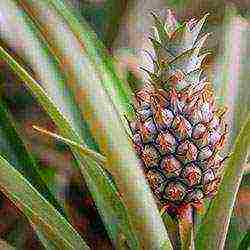 Lovers of indoor floriculture successfully grow a wide variety of plants at home, including exotic ones. It's not too hard to grow pineapple either. You just need to properly prepare and plant its green top, and then provide the plant with appropriate care. And in order to do everything right, it is better to follow exactly the step-by-step instructions with video and photo.
Lovers of indoor floriculture successfully grow a wide variety of plants at home, including exotic ones. It's not too hard to grow pineapple either. You just need to properly prepare and plant its green top, and then provide the plant with appropriate care. And in order to do everything right, it is better to follow exactly the step-by-step instructions with video and photo.
How to grow pineapple at home
Blooming or fruiting pineapple looks very unusual in the interior. Its appearance evokes admiration and even some surprise. In ordinary home conditions, it is not very common, although many growers are interested in trying to grow it. With proper care, this exotic plant takes root well in an apartment. Under favorable conditions, after 2.5-3 years, it can bloom and begin to bear fruit.
For planting pineapple in an apartment, use the green top of the fruit. For an experienced grower, in principle, there is nothing complicated in this process. You just need to properly root the top of the plant. But in order for an attempt to plant an exotic plant to be definitely crowned with success, it is necessary to pay attention to the following points:
- the correct choice of the fetus;
- careful preparation of planting material;
- planting the green top in the ground.
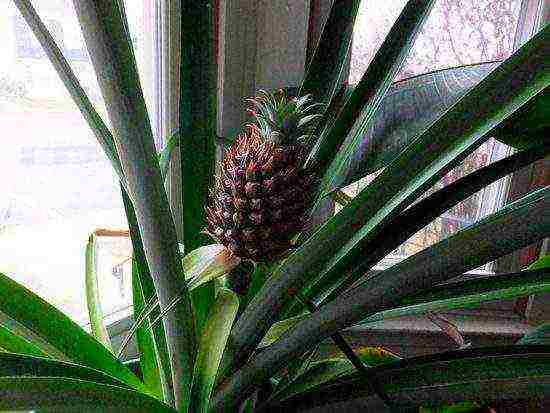
With good care, pineapple can bear fruit at home.
If done correctly, the tip will take root in the ground. In the future, when the plant takes root, it will need to be provided with appropriate care so that it grows and develops normally. Under favorable conditions for pineapple, after a few years, it will bloom and bear fruit. They are edible, only they will be smaller in size than plants found in their natural environment.
Choosing a fruit for planting
The correct choice of fruit is of great importance for the successful planting of pineapple. It should be ripe, free from rot and damage. Unripe or overripe fruits are not suitable for planting. But special attention should be paid to the green top of the pineapple, because it is it that is used for rooting.
The apical part should be strong and healthy, without any signs of decay, and the leaves on it should be fresh, rich green color, without brown spots. If the foliage on the fruit is sluggish or begins to dry out, then it is better to put aside such a fruit and choose another, healthier one.
Attention! For planting pineapple, it is preferable to use fruits purchased in spring or summer. Those bought in winter may be frostbitten, and such planting material is no longer suitable for growing.
If there are any doubts when choosing a pineapple for planting, it is better to buy two fruits at once, but take them in different stores. So the likelihood that at least one of them will be suitable will be much higher. And many growers do just that, then rooting two tops at once, on the basis that if not both, then one will definitely take root.
Preparing the tops of the pineapple for rooting
After buying a pineapple, the fruit itself can be used for its intended purpose, that is, eaten. For rooting, you only need its top with leaves. It must be carefully separated from the fetus itself. This can be done in one of two ways:
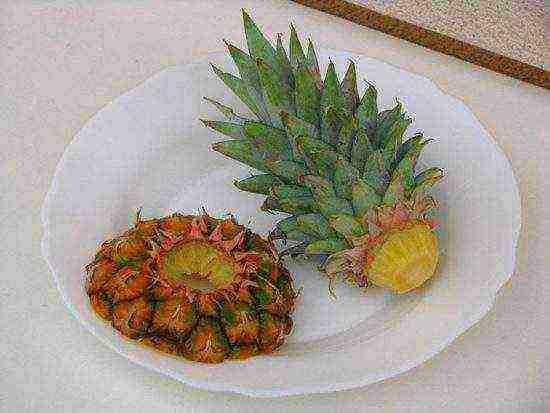
Pineapple top for planting
- unscrew the top;
- cut the apex out of the fruit.
If the pineapple is ripe, the tip can be unscrewed quite easily. To do this, you need to take the fruit itself with one hand, and with the other, grab its green top and start twisting it. It is necessary to hold it by the place closer to the base, and not by the leaves, so as not to damage them. Too much force when unscrewing can damage the tip. Therefore, if in this way it is impossible to separate it from the fruit, it is better to act differently - cut out the green top.
A sharp knife is used to cut the top off, holding it at a 45 degree angle. Carefully separating it from the fruit with a tool, then you need to carefully peel off the pulp, otherwise the top may rot in the future. Only it is necessary to act extremely carefully so as not to accidentally damage the points on it, from where the roots will then grow. With both methods of separating the tops, then you will need to remove the lower leaves by about 3-4 cm.
The apical part prepared in this way is often rooted in warm and settled water, using a container of a suitable size, preferably made of dark glass. The top is lowered into the liquid with its bare part, exposing the container with the plant in a warm and well-lit place, but not in the sun. The water is changed regularly, every 2-3 days. Roots should appear within a few days. When they grow up to 2-3 mm, the plant can be planted in the ground.
Landing in the ground
To plant the top, you need to take a sufficiently large container with a height of 20-30 cm and a diameter of about 30-35 cm.If such a pot is not at hand, you can plant the top first in a smaller container, and only then, as the plant grows, move it to more suitable. At the bottom, you need to lay out a drainage layer of expanded clay or pebbles, and on top of it fill the pot with nutritious soil, leaving some distance to the edge.

Stages of planting pineapple
For moistening and additional disinfection, it is better to spill the soil with boiling water or a solution of potassium permanganate. After about a day or two after that, pineapple can already be planted in such a prepared soil.
Advice. For planting, you can use ready-made purchased soil intended for bromeliads, or prepare the soil for pineapple yourself from humus, peat and river sand in equal proportions.
In properly prepared soil, make the hole slightly larger than the cutting of the top of a pineapple, lower it over the lower leaves and crush the soil around it. To protect the roots from decay, you can additionally add a little ash or crushed coal to the hole. The plant is placed in a warm, lighted place, avoiding direct sunlight. At a temperature of 25-27 degrees, the top will take root in the ground within 1.5-2 months.
In the summertime, pineapple can be placed on the balcony, protected from rain. In autumn and winter, it is usually kept on a windowsill or near a window. But at the same time, you need to pay attention to the fact that he is not in a draft. Caring for the plant will consist in regular watering, only without a strong waterlogging of the soil, spraying and wiping the leaves from dust, applying top dressing every 1-2 months.
A blooming pineapple or a plant with a fruit set looks very beautiful in the house. It can be a real decoration for any flower collection. Even a novice florist can grow it independently from the green top, because there are no big difficulties in this process, especially if you follow the instructions.
Growing pineapple: video
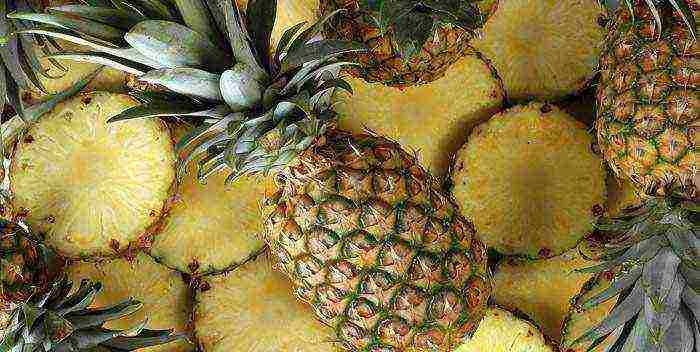
Who said you can't smell and taste the tropics in your living room? With the guide we've prepared just for you, you can plant a pineapple at home with a minimum of effort. Time and patience are what little it takes.If you are not afraid of long-term commitments and are ready to wait a couple of years to see the result of your patience, the pleasure that you will get from harvesting is guaranteed to exceed all your expectations.
There is a lot of controversy about whether pineapple is a fruit, vegetable, berry, or a regular herb. In almost all countries this fruit is called ananas, but the British decided to call it pineapple (pine apple), and the Spanish piña (pine cone). Initially, the word "pineapple" came to us from the Indians of the Tupi tribe and in the language of this people means "excellent fruit", so we will trust the primary sources and in our article we will call it that.
How to plant pineapple at home
So, you've decided to find out how to plant pineapple at home. With the photo and text description that you will find below, this will be almost no problem.
Step 1:
Pick a ripe, healthy pineapple from the market or any grocery store. It is best to buy in summer or early fall.
Tips for choosing a pineapple:
- Check that the leaves are free of traces of various diseases or insects, they must be firm, without yellow or brown spots.
- You need to make sure that the fruit is ripe, as only a ripe fruit can produce a new pineapple. Ripeness is determined by the golden color at the base of the fruit. The more the color of the base is closer to gold, the sweeter the pineapple. If it is completely golden, then this means that the fruit is already overripe and should not be taken.
- Ripe pineapple should smell pleasantly sweet. A too harsh sweetish aroma may mean that the fruit is rotten.
- When pressing on a ripe fruit, the elasticity of the peel will be felt, while it should spring slightly.
Step 2:
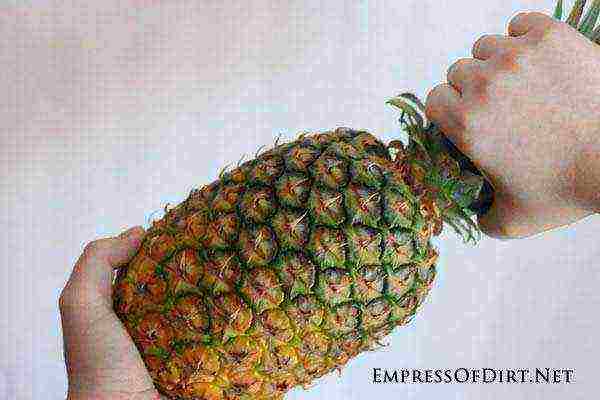
We will grow pineapple from the top. Separate the crown with leaves. It is important to make sure that the base where the leaves come together is intact, as the roots will grow through this very spot. There are several options:
1) you can unscrew the crown;
2) cut off the crown with a sharp knife.
The first option ensures that the base of the leaves remains intact. It is best to use gloves when loosening (but this is at your own discretion). Firmly grasp the leaves with your right hand, and with your left support the lower part of the fruit, while making rotational movements, after a while you will feel how the upper part will begin to give in. After all this, get rid of the remaining pulp, it can cause rotting, and remove the lower leaves 2-3 centimeters to slightly expose the stem.
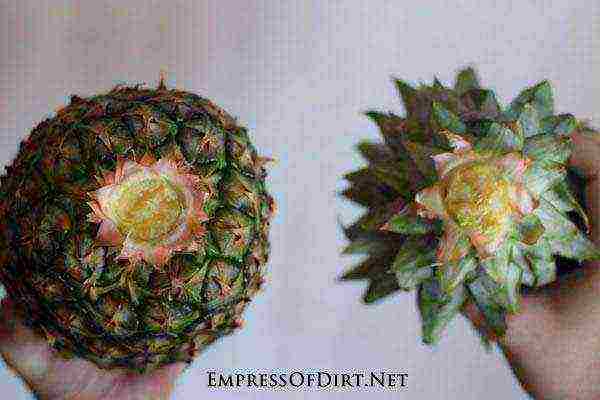
Step 3:
Lay, or best of all, hang the stem with the cut side up on a rope and let dry for a week. The places where you cut and removed the leaves should heal and harden. This is necessary in order to proceed to the next stage.
It's important to know
Because of its high acidity, pineapple juice in large quantities can be harmful to tooth enamel, so try not to eat too much at a time.
Step 4:
Fill a glass with water. The neck of the container should be large enough to accommodate the base of the stem, but small enough to fit three to four toothpicks on the sides of the support and prevent the crown of leaves from completely submerging in the water.
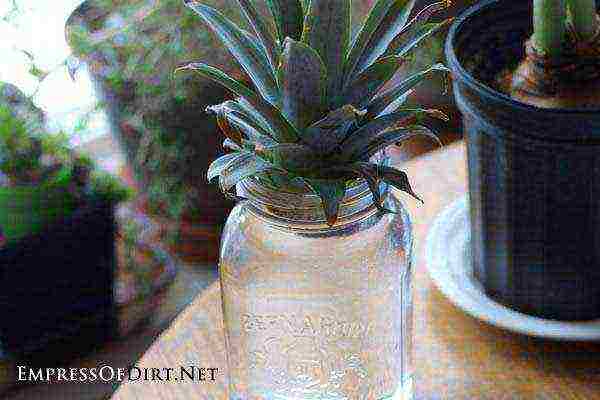
Step 5:
Next, you should glass on a window that is on the sunny side and wait for the roots to sprout. This can last anywhere from a couple of days to two weeks. During this period, avoid extreme temperatures, the room should not be below 14 ° C and above 26 ° C. Change the water every few days to avoid mold.
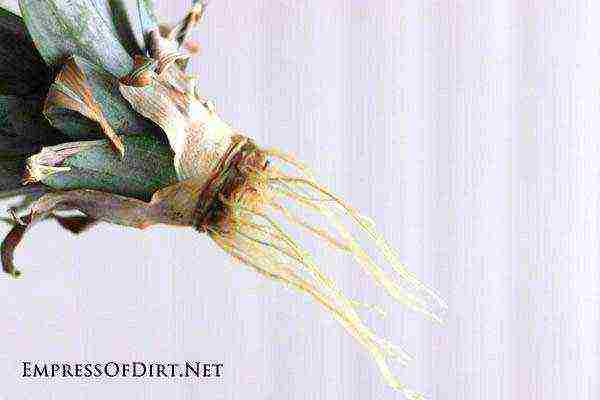
Step 6:
Prepare a pot of soil. Fill a 15-centimeter pot with soil from any garden, it contains about 30% organic ingredients. This combination of nutrients is ideal for the plant.
Step 7:
Plant the pineapple in a pot when the roots have sprouted 4 to 6 centimeters.If planted too early, our fruit will not grow well. Remember to compact the soil firmly. Keep the plant in a warm, sunny and humid environment and make sure that the temperature does not drop below 18 degrees at night.

Step 8:
Water the soil every two weeks. You need to fertilize the plant twice a month during the summer season, this will be enough for full and harmonious growth. Pineapple grows faster in the warm season, when the sun is for a long time, the sun is shining, and, accordingly, in winter, when the days become shorter, growth will slow down.
Step 9:
After a year, transplant the pineapple into a larger pot and wait for the flowers to appear. The red flower should grow from the center of the leaves and eventually turn blue, and eventually the long-awaited fruit. The transition from the “flower” phase to the “fruit” phase lasts about 6 months.
It is interesting
Pineapple can be an excellent anti-cellulite remedy. It contains the enzyme bromelain, which improves digestion, accelerates the breakdown of protein and fats, and increases the supply of amino acids to the body.
Of course, in total it can take several years, but believe me, it's worth it!
How to take care of pineapple
- Pineapple is a tropical fruit, so frost and cold temperatures can kill it. They should receive at least 6 hours of bright light. During the day, you should put the pot on the window, and at night, remove it from the window to avoid frostbite.
- Over-watering and overfeeding are two of the best ways to kill your baby. Keep the plant slightly moist, but never allow the soil to become marshy or dry, like bone in the desert.
- Since pineapple grows at home, it must be regularly sprayed with a spray bottle. In summer - 2 times a week, in winter - once a week.
- Remember to pick off old leaves when they die to provide light and air for new ones that are just sprouting.
- A small plant will produce small fruits, but don't worry - they will also be very juicy and rich in flavor. When you see that the pineapple has become evenly ripe and acquired a golden yellow color, you can safely pluck it.
- If you have a private home, in the summer it will be better to take the pineapple out to the porch or garden, where it can grow better. A well-lit balcony on the sunny side is suitable for the apartment.
- Like any other houseplant, pineapple is virtually immune to pest threats. If you do notice indoor insects, you can easily get rid of them by rinsing the leaves first with soapy water and then with clean water.

A few things that come in handy when growing pineapple at home. What is worth knowing
- Pineapples don't need a lot of water. They have very strong and persistent leaves, so they do not lose much moisture on evaporation. Pineapples can survive for a very long time even with the smallest amount of water, as they receive a lot of water and nutrients through the leaves.
- This plant does not need a lot of land or high quality soil. They belong to the bromeliad family and, like all bromeliads, do not have a large root system.
They thrive in the slightly acidic soil found in most gardens. They dislike excessively damp, flooded soil and frost. - Two pineapple slices contain the daily requirement of vitamin C, as well as a complex of minerals such as phosphorus, iodine, zinc, copper.
- The roots grow into the ground in a couple of months, and in 2-3 years you will grow a full-fledged fruit, and while it grows, you can enjoy the sight of unusual spiky tropical leaves and show off to your friends and acquaintances.
Video "How to grow pineapple at home from the top"
In this video, you will learn how to plant pineapple at home. The author shows in detail and step by step what needs to be done for this.If you have never grown pineapples before, then this video is perfect for you.
 Today you cannot find such a person who has not heard of pineapple. Native to the subtropics, this exotic fruit is exported to most countries. And surely many had a desire to eat pineapple grown by their own hands.
Today you cannot find such a person who has not heard of pineapple. Native to the subtropics, this exotic fruit is exported to most countries. And surely many had a desire to eat pineapple grown by their own hands.
It is quite possible to implement such an idea, because with the right approach, you can get fruit of approximately the same quality at home or in a greenhouse.
Description of the pineapple plant
 Pineapple is a perennial plant that forms dense leaves during the growing season, forming a dense rosette. An important part of the pineapple is root rosette, from which a thick and massive stem is formed.
Pineapple is a perennial plant that forms dense leaves during the growing season, forming a dense rosette. An important part of the pineapple is root rosette, from which a thick and massive stem is formed.
Subsequently, a peduncle 50 cm long grows at its top.Pineapple flowers are spicate, during ripening at the top of the peduncle it grows rosette with bracts.
You can understand what an outlet looks like by looking at a store where pineapple plants are sold. The homeland of this fruit is Brazil. Therefore, it is not surprising that here, as well as in Venezuela, Paraguay and Colombia, it is one of the most popular fruits... Pineapple includes about 8 different varieties.
Surely at least once, when tasting this fruit, many had the idea of growing pineapple at home. There is no obstacle here, and the fact that pineapple is a tropical fruit. The main thing - find suitable conditionsin which this fruit will be grown.
Preparation of planting material
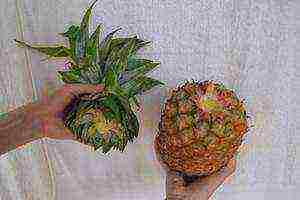 To save yourself from possible difficulties and at the same time be sure that the efforts spent will not be in vain, it is recommended to use crown planting method or rosettes of leaves. Before starting the growing process, you need to carefully examine the pineapple.
To save yourself from possible difficulties and at the same time be sure that the efforts spent will not be in vain, it is recommended to use crown planting method or rosettes of leaves. Before starting the growing process, you need to carefully examine the pineapple.
Suitable for growing at home only ripe fruit, the crest of which should not show signs of disease and other defects.
Do not use fruit purchased in winter for planting. Indeed, at this time of year, pineapple is stored in cold conditions, so the tuft rosette is often damaged by frost. Therefore, it will not be possible to grow pineapple from such a fruit.
- It is best to plan pineapple planting in the summer or early fall, when fruit of suitable quality can be purchased.
- The chances of your venture succeeding are higher if you buy a pineapple with an intact tuft center and juicy green leaves.
- When the fruit is in your hands, you need to take a sharp knife and carefully separate the top from it, while trying not to damage the core. Sometimes flesh may be present on the trimmed top. In this case, it must be removed, otherwise the trunk will subsequently begin to rot.
- In addition, the lower rows of leaves should be cut off. Then you will be able to clearly see the trunk of the plant, which is usually about 1 cm high.
- Having finished trimming, you need to give the tuft time to dry. To do this, it is left upright for two weeks. This time will be enough for him so that the wounds on the surface of the cutting can heal.
Subsequently, the plant will use the nutrients to form the root system. Most often, after 2-3 weeks, the crest reaches the desired state, after which it is already possible to proceed to planting.
Capacity and soil
When growing pineapple at home, you will definitely need a special potting mix, as well as a container where you plant the pineapple.
-
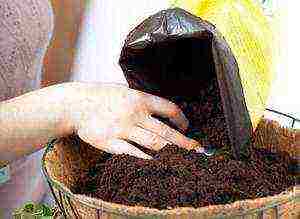 The capacity can be any flower pot at hand. The main thing is that it should be slightly larger than the tuft in size. It is best if there are holes in the container through which excess moisture will be removed.
The capacity can be any flower pot at hand. The main thing is that it should be slightly larger than the tuft in size. It is best if there are holes in the container through which excess moisture will be removed. - First of all, the pot must be filled with shards, on which a layer of expanded clay or pebbles is already laid out with a layer of about 2 cm.A mixture based on peat and river sand, taken in equal amounts, is used as a planting substrate.
- When a few days remain before planting the tuft, it is necessary to disinfect the substrate by thoroughly watering it with boiling water. Such processing will provide optimal soil moisture before planting a socket in it. You can place the outlet in the substrate without waiting for the complete absorption of moisture.
Planting pineapple
 When all the necessary operations with the land have been carried out, the tuft begins to be planted. It should be placed in the ground so that the lower leaves are at the level of the soil. In conclusion, it is necessary compact the soil thoroughly.
When all the necessary operations with the land have been carried out, the tuft begins to be planted. It should be placed in the ground so that the lower leaves are at the level of the soil. In conclusion, it is necessary compact the soil thoroughly.
After that, you definitely need water the ground well, spray, and finally cover the pot with a cap or pull on a plastic bag. The result will be a kind of greenhouse.
Next, the pineapple pot is transferred in a warm and well-lit a place. Care must be taken to protect it from direct sunlight.
After about a month, the crest will begin to take root. However, until the first roots appear, the plant cannot be watered. To maintain humidity, you can only limit yourself to regular spraying of the leaves.
Transplant and watering rules
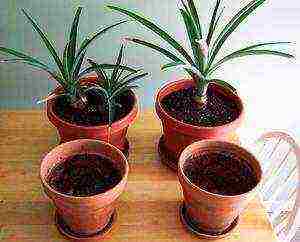 When the pineapple rosette takes root, it is transplanted into a larger pot... In this case, the operation is carried out in accordance with the same scheme as in the case of the first planting of the plant. After transplanting, the pot with the plant must be covered with a cap.
When the pineapple rosette takes root, it is transplanted into a larger pot... In this case, the operation is carried out in accordance with the same scheme as in the case of the first planting of the plant. After transplanting, the pot with the plant must be covered with a cap.
After two to three weeks, the shelter can be removed. For watering, you can only use warm or hot water... Watering should be done infrequently, but in moderation, keeping an eye on when the soil begins to dry out.
As the leaves develop, water will collect in the leaf axils, which will stimulate the formation of new roots. Considering that pineapple tolerates long periods of drought and is responsive to light, with the arrival of summer it can be transferred to a sunny place or to a balcony.
At the first sign of approaching rain, the plant must be removed inside. To create pineapple conditions as close to natural as possible, it can move to the greenhousewhere tomatoes or cucumbers are grown.
Conditions for pineapple and feeding
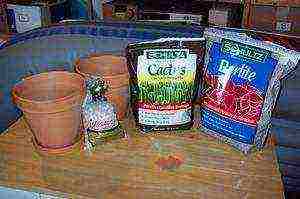 In order for a pineapple to grow well at home, it needs to create comfortable temperature - within 20-25 degrees.
In order for a pineapple to grow well at home, it needs to create comfortable temperature - within 20-25 degrees.
In the process of development, the plant must be provided with fertilizers. They should be entered no more than twice a month. Pineapple infusion can provide essential nutrients.
You can also replace it mineral fertilizershowever, in this case, their consumption rate must be halved compared to other plants. At the end of summer, when the temperature outside begins to decrease, the plant is brought inside, where it is necessary to choose the most illuminated place for it.
How to stimulate pineapple flowering
 During the first two years after planting, the pineapple needs to be properly cared for so that it can accumulate enough strength to enter the flowering phase. However, sometimes it happens that the plant begins to bloom later than the specified period.
During the first two years after planting, the pineapple needs to be properly cared for so that it can accumulate enough strength to enter the flowering phase. However, sometimes it happens that the plant begins to bloom later than the specified period.
If you are faced with a similar problem, while providing proper care throughout the entire time, then you will have to spend special events to stimulate flowering.
- usually, the desired effect can be achieved with the help of ethylene; for its preparation, it is necessary to take one teaspoon of calcium carbide and dilute it in 0.5 liters of water;
- when the solution is ready, it is insisted for 24 hours;
- further, it must be filtered, trying to separate the liquid from the sediment that forms at the bottom of the can;
- the resulting liquid must be treated with the central part of the leaf outlet once a day for a week.
As a result of this operation, pretty soon the pineapple will begin to bloom, which will last approximately 1-2 months.
Reproduction of pineapple after fruiting
When growing pineapple from the top, one should not forget that it is a herbaceous plant, therefore, after fruiting, it does not go into a state of dormancy, but dies. But often this process can take a long time and take several years.
The mother plant can form many small shootsthat can be used to get new plants. After waiting for the formation of young roots in them, they should be separated, after which they are transplanted into separate pots.
As a rule, plants obtained from young shoots enter the flowering phase much earlier than pineapple bushes, which were obtained from a tuft.
Seed propagation of pineapple
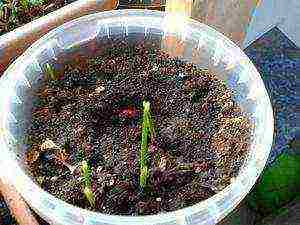 An alternative to growing pineapple from the top is to sow seeds. To do this, you need to choose enough ripe fruit and extract brown seeds from it. Further, they are placed in a weak solution of potassium permanganate, and after this treatment, they are allowed to dry.
An alternative to growing pineapple from the top is to sow seeds. To do this, you need to choose enough ripe fruit and extract brown seeds from it. Further, they are placed in a weak solution of potassium permanganate, and after this treatment, they are allowed to dry.
Next, they prepare the soil for sowing. It is best to plant the seeds in a substrate made from a mixture of leaf earth, sand and peatto be taken in equal amounts.
When sowing, the seeds must be buried 2 cm. After that be sure to water the substrate with warm water, and over the container with seeds, stretch a film or install a hood. Then the pots are transferred to a warm place.
Particular attention should be paid to creating an optimal temperature regime, since this largely determines the time of the appearance of the first shoots.
It is impossible to say exactly when the seeds will germinate. Therefore, you have to be patient. Sometimes seeds hatch after 2 months, and in some cases you have to wait six months.
In the process of caring for young seedlings, it is necessary not only to water and spray them regularly, but also feedusing chicken manure or mineral additives as fertilizer.
Pineapple is one of the most popular exotic fruits that each of us has probably heard of. But if you want, you can enjoy home-grown pineapple. You can master this task if you get acquainted with agricultural technology growing it.
The most popular method for growing pineapple is using the top of the fruit. To obtain a fruiting plant from it, you will have to not only prepare the soil of a suitable composition, but also create favorable conditions for growth.
First of all, this concerns the temperature, because pineapple is grown in the tropics. Therefore, it is necessary not only to plant the pineapple correctly, but also to provide it with the appropriate temperature regime.

